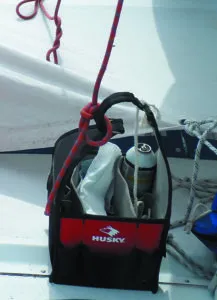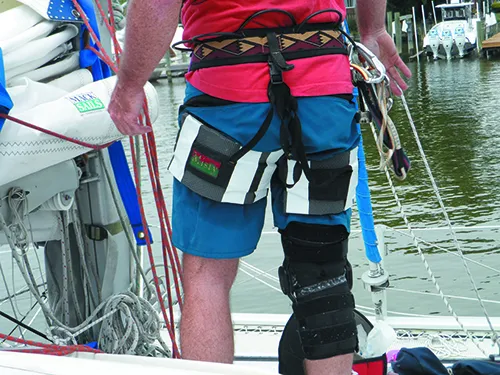Early summer is about the time we notice that something needs our attention at the top of the mast—an antennae connection, faulty mast light, lost halyard, etc. This is not the sort of job for a novice. Before going aloft for the first time, I recommend you take class on climbing with a rigger knowledgeable in the method you will using.
Harness Fit
There must be no possibility of falling out, even combined with the impact of an upside down fall. It is always possible to lean too far to one side, become inverted, and fall head first.
A UIAA- or OSHA- approved a harness is required, and few bosun’s chairs fully meet these requirements. Thus the climber must either wear a full body harness or a tightly fitted UIAA approved seat harness that cannot, under any imaginable circumstances, be pushed or pulled down over your hips. The waistband must be tight over your natural waist. If not, don’t climb. While a boson’s chair is more comfortable than most climbing harnesses, in most cases you need to wear a harness as well.
OSHA requires two attachment points. There are three common mast climbing methods: hoisted by halyard alone or with a tackle, climbing a halyard using ascenders (ATN Top Climber or similar), and climbing some manner of ladder (mast steps or MastMate). While you might know someone who goes up on a single line all the time, occasionally that line fails. I know of two tragic accidents personally. It is not worth the risk.
If you must be hoisted on a single line, you need to be 100 percent certain that the rope, pulley, and all hardware are in pristine condition. If not, have a crew member belay you with a second halyard wrapped around a winch, or use a rope grabber on a second halyard.

keep tools handy while working.
Tool Bag
While there are traditional, purpose-built rigging bags, I like a small electrician’s bag. These have been perfected for hanging off ladders. Dump it out and fill with only what you need for the job at hand, do not use the outside pockets (something will fall out) and pick a simple design. Remember some rags to wipe grease off your hands.
I dislike boson’s chairs with tool pockets, as stuff tends to fall out of these pockets. This puts your helper below at risk. Use a separate halyard to raise it, attaching it to the bosun’s chair risks a spill. It can be lowered and a helper can send up what you need. For more details on ascending the mast, see the PS Online blog post “Going Aloft Safely.”









































As for me, I would use a good basic full body climbing harness like this one in the url below. My harness is very similar but the fastenings are double “D rings”. I like the double d’s since I can adjust it once and it is always tight. The down side is you have to readjust for seasonal wear. I can be in my harness for about an hour before I start noticing the start of discomfort. Our team used to climb lattice towers and monopoles and be suspended for hours at a time. Do not forget to use 2 attach points and never take both off ( i.e. halyard 1 and halyard 2). Use a bowline and not the halyard connections.
https://planksupply.com/products/fall-protection/safety-harnesses/full-body-5pt-qcb-grommet-leg-tool-belt-harness/?attribute_pa_color_harness=blue&attribute_pa_size_harness=lg&gclid=CjwKCAjwyvaJBhBpEiwA8d38vJvXdUgUg5PZ33ctpMCGg85r5YFJ7OKHmMypalQu6m_J5ECBJSr8QxoCQDkQAvD_BwE
https://planksupply.com/products/fall-protection/safety-harnesses/full-body-5pt-qcb-grommet-leg-tool-belt-harness/?attribute_pa_color_harness=blue&attribute_pa_size_harness=lg&gclid=CjwKCAjwyvaJBhBpEiwA8d38vJvXdUgUg5PZ33ctpMCGg85r5YFJ7OKHmMypalQu6m_J5ECBJSr8QxoCQDkQAvD_BwE
It’s always amazed me that people go up masts with a typical bosuns chair and no climbing hardness. I’ve done a bit of mountaineering, and a climbing harness is mandatory for going up the mast. The bosun’s chair is comfy and all that, but there is always risk of inversion. And this at the dock; offshore, it’s probable. Great recommendation.
The problem with MOST full body harnesses, other than those designed for tower work or suspension, is that the load on the leg loops is outwards from the groin, pinching off the femoral artery (suspension trauma), they lack leg loop padding, and they lack twin D-rings.
The load on climbing/suspension harnesses is from behind, under the butt, instead of outwards, from the groin. If there are twin D-rings, and they are rigged with a spreader, this solves the problem, but the worker will now have trouble getting above the masthead, since the attachment point is at his sternum, plus the knot plus the blocks. The masthead ends up at collarbone height, which I don’t like.
Leg padding can be added.
Personally, I find rock climbing harnesses with additional padding to be more convenient. Masthead work is different from tower climbing. Arborist harnesses are another option. the key factor with climbing and arborist harnesses is that you MUST have a defined waist (minimal gut) so that the harness cannot slide over your hips if inverted. This is the main reason OSHA harnesses are full body–the regulation must fit all shapes. Arborists and climbers tend to be fit and understand this limitation.
Expert riggers (this image of the late Brian Toss) like modified climbing harnesses. The are more mobile and very safe. https://lh3.googleusercontent.com/proxy/R5T9SumiauzkncWml4oOeAJL0vB5WvZYwQm7001HhTG6e8UE6Ay-uJ-DREjr0YPPuScbos5U17pheaIFpUJJv3h9c3c7sMsqnDKn4CzWtLKyOMeDJ3AS-m4
If I wanted a full body harness, there are simpler, more comfortable full body harnesses. Yates Rigger’s Harness. https://cdn11.bigcommerce.com/s-97767/images/stencil/500×659/products/3410/4143/386__89207.1506012623.jpg?c=2